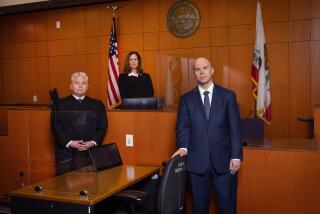Sheriff Lee Baca to unseal the Ruben Salazar files
Los Angeles County Sheriff Lee Baca told The Times on Monday that he will allow the media to review eight boxes of documents related to the slaying of journalist Ruben Salazar, a case that has been clouded by controversy and speculation for 40 years.
Baca said the records, long kept from public view, will be available after the Office of Independent Review formally releases its report on Salazar’s slaying Tuesday. A draft copy of that report was obtained by The Times and made public over the weekend.
Documents: The Ruben Salazar Files, a reporter under law enforcement scrutiny much of his career
Reporters will be allowed to review the records under the supervision of sheriff’s employees, though no copies will be provided, and no cameras will be allowed, Baca said.
“I’m willing to share the information, but I don’t think I can share ownership,” Baca said. “In today’s world with whatever technology is out there, I think original documents must remain original. I don’t think anybody else should be taking these documents, blacking out parts of these documents. ... I’m extraordinarily aware that documents can be altered.”
Salazar’s relatives in recent months have been allowed access to the records, but had to sign confidentiality agreements preventing them from discussing the information.
Salazar was an award-winning Times reporter and KMEX-TV news director. His killing became a monumental moment in the Mexican American civil rights movement. After his death, Salazar became an iconic figure, with parks, schools, scholarships and even a U.S. postage stamp named in his honor.
The report by the Sheriff’s Department’s civilian watchdog concluded that a series of tactical mistakes by deputies led to the Aug. 29, 1970, slaying of the newsman. Salazar was shot in the head by a tear-gas missile as he took a break in a bar while covering a demonstration in East Los Angeles that had become a riot.
In the weeks leading up to his slaying, Salazar and his KMEX crew had been investigating allegations of misconduct by sheriff’s deputies and Los Angeles police. The newsman had told friends that he thought he was being shadowed by authorities and feared they might do something to discredit his reporting.
The report also said there was no evidence that deputies had Salazar under surveillance or intentionally targeted the newsman after he entered the Silver Dollar Cafe.
The report acknowledged that its conclusions were limited on the key issue in Salazar’s slaying -- whether he was a victim of a plot by authorities -- because sheriff’s homicide detectives at the time discounted theories that the newsman was killed intentionally. As a result, they failed to ask questions that might have prevented the speculation and conspiracy theories that haunt the case to this day.
Baca said the Office of Independent Review’s report detailing deputies’ actions leading up to Salazar’s death shows how far the department has come in the last four decades. Deputies today, Baca said, receive more training and are under tougher scrutiny from supervisors. Tear gas, for example, could not be shot into an occupied space under current protocol without approval from a higher-up.
“We would leave the problem intact until we had the right resources to go after someone with a gun,” Baca said.
Though Baca acknowledged shortcomings in the department’s handling of the incident, he also laid blame on rioters. Baca, a young sergeant at the time, was present at the demonstration, and said he saw out-of-town protesters breaking benches, smashing windows and throwing rocks at deputies.
“I don’t think it gave the department a black eye as much as it was tragedy that was unintended by the department and the deputies,” Baca said. “The black eye, if there’s any black eye, was the extraordinary amount of rioting going on during Mr. Salazar’s death ... the nature of rioting can lead to consequences unintended.”
“I don’t think that’s an excuse for what happened to Mr. Salazar ... but Mr. Salazar would not have been there in that cafe if he didn’t feel the danger in the community,” he said.
Baca said the department today would investigate a similar incident more thoroughly. Along with a probe by homicide detectives, the training bureau would examine deputies’ actions for potential policy violations, Baca said.
The incident would also be reviewed by the OIR, he said, so no conclusions would be arrived at “without any outside eyes.”
Baca said he also disagreed with former Los Angeles Police Chief Ed Davis’ response to Salazar’s reporting, particularly a 1970 meeting the former chief had with Salazar. Davis angrily accused Salazar of fabricating information about a meeting he had with Latino journalists.
“In today’s generation of law-enforcement leaders, we wouldn’t do that,” Baca said. “We understand that freedom of press is all about criticism, and it’s part of what the press is obligated to do to keep government from getting away with everything it can get away with it.”
That meeting, Baca said, may have been why Salazar was worried he was being followed.
More to Read
Sign up for Essential California
The most important California stories and recommendations in your inbox every morning.
You may occasionally receive promotional content from the Los Angeles Times.












